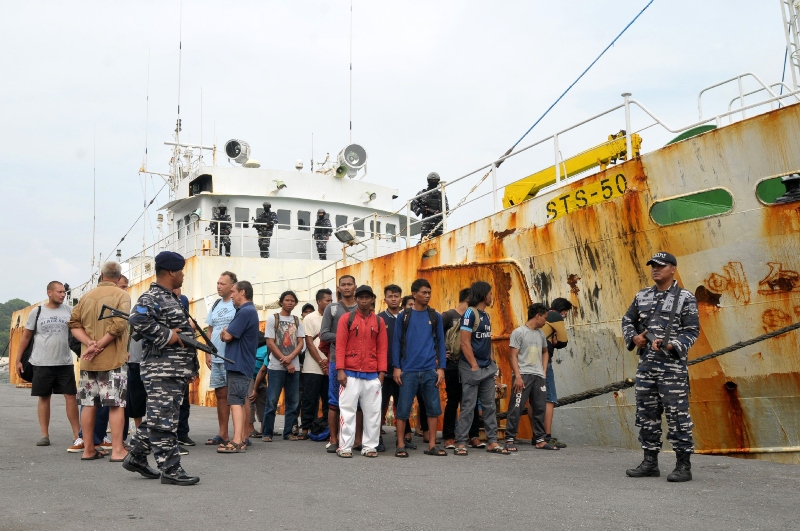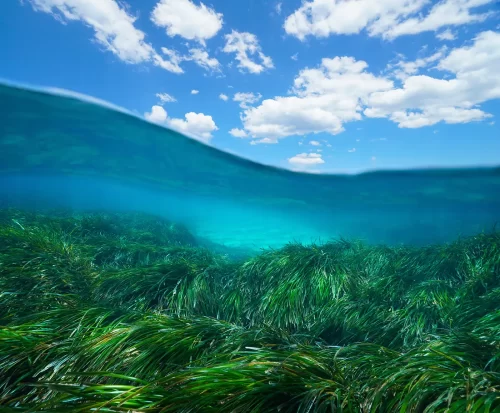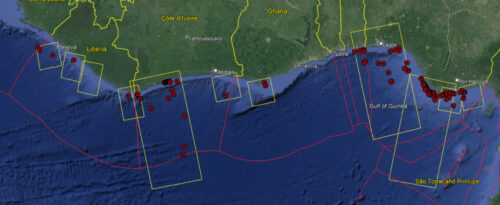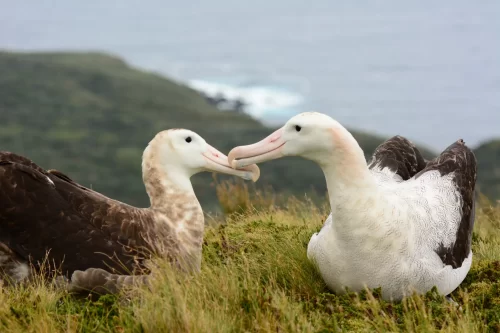Satellite technology can offer cost-effective solutions to ocean governance, but stakeholders must work together to be successful

Indonesian military guard a crew next to the STS-50, a seized alleged “slave ship,” at the naval port of Sabang, following a dramatic high seas chase.
Forced labor is used in fishing fleets around the world—a fact that is becoming known all too well. While not every fishing operation succumbs to such practices, unscrupulous employers will often commodify and exploit workers in order to maximize their profits.
Operators that treat their crews poorly are more likely to engage in illegal fishing and vice-versa, damaging the reputation of the wider fishing industry, including those that conduct their business responsibly. Because commercial fishing takes place across jurisdictional boundaries and is largely conducted out of sight and reach of authorities, it is perhaps the ideal sector for forced labor to be used, and go undetected. The Trafficking in Persons Report issued by the U.S. Department of State outlines cases of trafficking within 189 countries. In 2021, information on more than 50 countries specifically referenced the presence of trafficking and forced labor within the fishing sector.
Addressing forced labor in fishing is complicated. A network of recruiters, agents and fishing operators take advantage of those determined to earn a living, making them increasingly vulnerable with each border crossed, identification document withheld and signature requested on an agreement that’s written in a language other than their native tongue. Those who thought they were setting out to work on a building site, a merchant vessel or a farm in another country find themselves trapped on board a fishing vessel, working in unsafe—even abusive—conditions without adequate rest, pay or means of leaving.
Satellite technology cannot eradicate forced labor in fishing or address the trafficking of workers onto vessels. Nor can it identify forced labor at sea with certainty. But a recent study, conducted by the University of California, Santa Barbara and Global Fishing Watch, found that satellite technology can help to identify vessels that are at risk of using forced labor, and flag that further investigation is needed by competent authorities. Using machine learning techniques and analysis of automatic identification systems data, a model was built that analyzed vessel behavior and compared it with vessels known to have conducted forced labor, as defined by the reported presence of one or more of the International Labour Organization (ILO) Indicators of Forced Labour. The model identifies vessel behavior observed as statistically similar to the known cases, and predicts these are at high risk of engaging in labor abuses.
But this is only a model—a proof of concept—rather than a tool that can be used with a high degree of confidence. To make it operational, we need to ground-truth the model predictions with data from those working in the sector and cross-reference its identifications with more known cases of forced labor, including cases where we are sure no forced labor is present. This will require us to look across vessel types, gear types and flag States. And to do that, we need help.
Over the next 18 months, we will be working with Huw Thomas, a specialist in responsible sourcing and seafood supply chain management, and John Maefiti, an expert on the crewing and operations of commercial fishing vessels, to improve our forced labor risk model. I sat down with them to discuss next steps for Global Fishing Watch.
Q: What challenges do you see with using the current Global Fishing Watch model to support efforts in tackling forced labor in fishing?
Huw: A significant barrier has long been the ability to see what is happening over the horizon. Efforts in the past 10 years have vastly improved visibility, but as our ability to peel back the layers to see what is happening has improved, we are now only understanding the true extent of the problem that needs to be addressed. The lack of awareness means data and information is absent, poorly collected and interpreted. The model that is being developed must overcome the data challenges and demonstrate its value so that more information is made available to refine and improve it over time.
John: From my experience, there have been no regulations, standards, certifications, or code of conduct on forced labor in the fishing industry throughout the Pacific over the past decades. Port State inspections are focused on fisheries management for scientific analysis and verification of the legality of the catch—not data on forced labor incidents on fishing vessels. One of the biggest challenges I see is whether or not port State inspectors have the confidence to use this model to predict the risk of forced labor on vessels they inspect because, after all, you still need hard evidence to prove if incidence of forced labor really occurs on the vessels.
Q: What needs to be done to take the model from a proof-of-concept to a useful and cost-effective tool?
Huw: The first and perhaps most important step is improving the dataset used to inform the technology, increasing the confidence in the output. Data needs to be provided by both governments and industry alike, recognizing the different perspectives and granularity that they can give. Retailers and seafood brands that we have spoken to understand the need to widen the dataset available and improve the output, but have little ability to overcome some of the barriers to securing the information needed. We are calling on all sectors to step up, share information and help us to refine the model so that it becomes an effective and useful tool for all.
John: First and foremost, more data needs to be imputed into the model to improve it. After that, ground truthing and expert analysis are needed across the project advisory group to bring more in depth analysis and review on the findings from the model. This will improve it from a proof-of-concept to a useful and cost-effective tool. But to make the model more relevant to the port States, industry and the markets, the model should align with international laboor regulations like the ILO Work in Fishing Convention, Western and Central Pacific Fisheries Commission Measures and Resolutions, Pacific Forum Fisheries Agency Minimum Terms and Conditions and social accountability standards which will be sooner or later be key to market access requirements and consumer demands.
Q: What can fishers, port inspectors and fisheries observers do to help create a clearer picture of work in fishing?
Huw: Ground truthing both the information used to inform the model, as well as the output indicators, will require data that can be validated. Vessel owners that want to demonstrate their dissociation from the worst kinds of abuse in the seafood industry can step up and share their information. We recognize that some of this information needs to be kept confidential, and we will work with anyone to achieve confidentiality whilst maintaining the integrity of the output. To ensure balance is maintained, port inspectors will be required to not only provide insight into the types of issues they find but also inform us of cases where no labor issues are found on board.
John: In any model or database system, the credibility of the data is very important. Hence, the people who collect data—fishers, port inspectors and fisheries observers—need to know the value and importance of the data they are collecting. They also need to know why they are collecting those data and how to verify the data if there are questions that arise with its credibility. They will also need to use their experience to verify that what the model is saying rings true and it aligns with what is actually taking place on the vessels.
Q: How can seafood industry organizations help to transform the forced labor model into an effective tool?
Huw: The work that helped develop the initial model relied on limited publicly available data. Seafood industry organizations —whether port based traders, large retailers or fish processors who have access to verifiable information —can all share data with us to help advance the model. We have already spoken to industry associations and those working to address labor rights in the seafood supply chain, but we need more information. Global Fishing watch is committed to working with those in the seafood industry and understands the need for confidentiality or redacted information around sensitive issues like data sharing. We’ll be reaching out to stakeholders over the next 15 months to help them recognize the value of the information they hold. Knowledge is power and we encourage seafood industry organizations to come forward to work with us collaboratively.
John: For industry, data confidentiality is very important. However, now more than ever, there is a call for more traceability and transparency in the fisheries sector. Consumers want to know where their seafood comes from and whether it is sourced legally. The seafood industry can help by sharing information towards the model—the benefits from these partnerships can help them to improve their social accountability performance to meet market access requirements.
Q: What do you personally hope we achieve in carrying out this work??
Huw: For nearly a decade I have personally worked to stop human rights abuses from occurring on board fishing vessels. If the Global Fishing Watch model helps bring this ambition a step closer to realization, then it will have been worth the effort. I recognize that a risk model will never be the silver bullet to solve all issues, but hopefully it will provide insight to port inspectors, seafood buyers and civil society to tackle these problems. Global Fishing Watch has proven that it can catalyze change with governments, and I hope that an equally tangible change can happen through market engagement as well.
John: As a former crewing agent, I was always dedicated to providing a good and decent working environment for the crew that I was placing on distant water fishing vessels. I hope to contribute to the legal and social framework that safeguards all the fishers working in the seafood industry, not just in the Pacific region but the rest of the world. A good and healthy workforce will always improve the productivity of any organization. The use of innovative and affordable technology is the way forward for Pacific region to improve the environmental and social standards in its fisheries.
If you have access to fishing vessel audit or inspection data that may support this work, please get in touch. Global Fishing Watch uses transparency to drive fair and effective governance of marine resources. The publication of vessel data and its analyses are not a magic solution to the presence of forced labor in fishing. It is, however, one source of information that relevant authorities can use to assess risk and inform targeted actions. Making information and tools publicly available, and for free, can help increase the use of risk-based vessel inspections, minimizing opportunities for the exploitation of fisheries and fishers to go undetected. We hope you’ll join us in this endeavor.
Huw Thomas, John Maefiti and Courtney Farthing work on the forced labor risk team at Global Fishing Watch.


